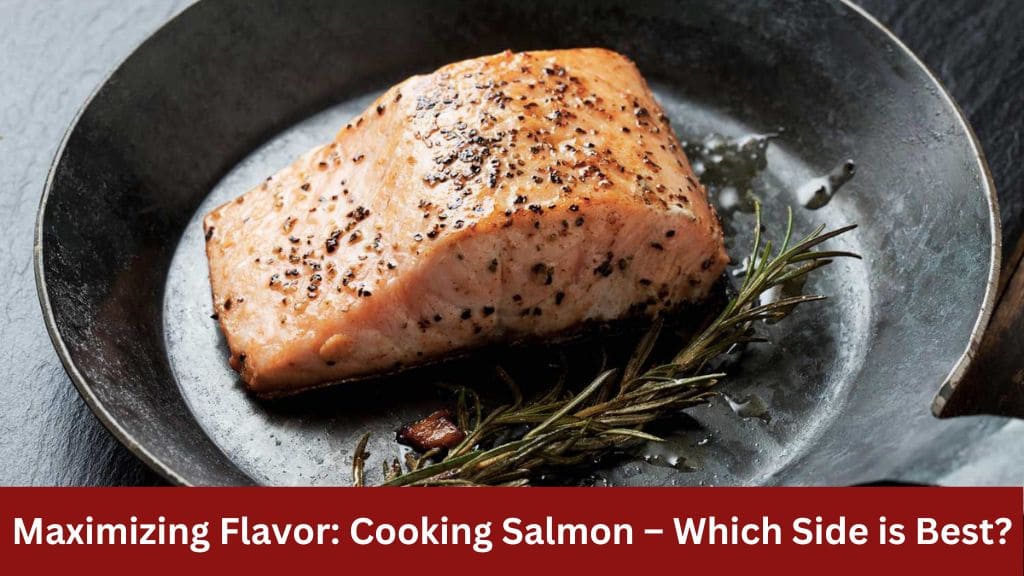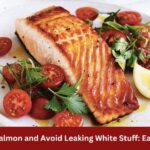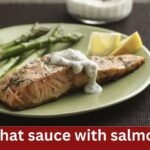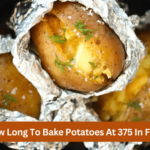Salmon is a versatile and delicious fish that can be prepared in numerous ways. Whether you prefer it well-done, medium, or even rare, the way you cook salmon can significantly affect its flavor and texture. One of the most important aspects of cooking salmon is deciding which side to cook first. In this blog post, we will explore the best practices for cooking salmon, focusing on why you should start with the skin side down. We’ll also provide tips and techniques for achieving the perfect salmon every time.
Why Cook Salmon Skin Side Down?
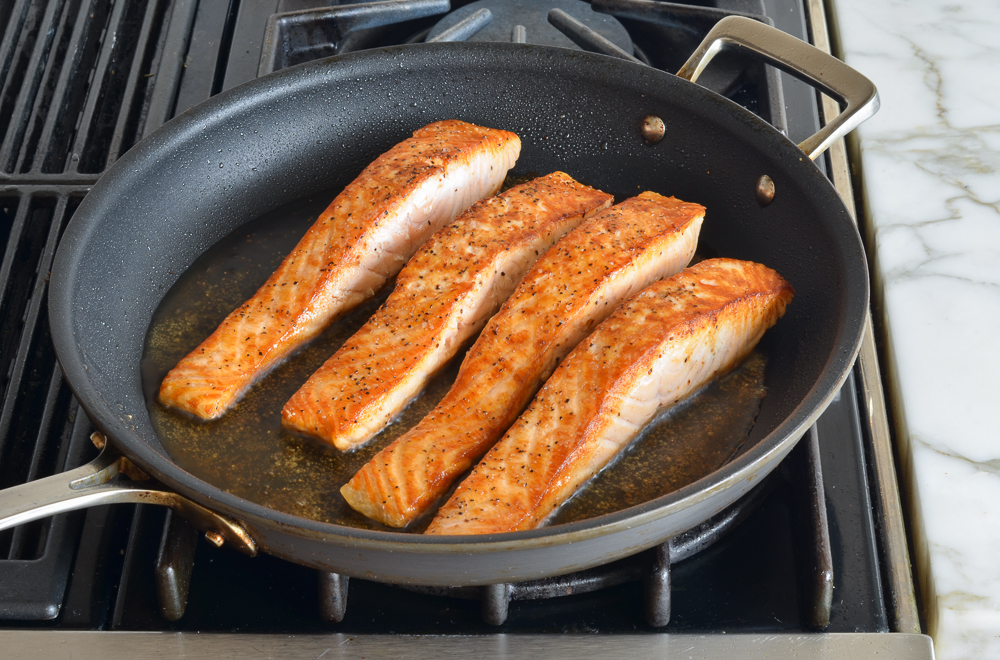
1. Crispy Skin
One of the primary reasons for starting with the skin side down is to achieve a crispy skin. When salmon is cooked skin side down, the skin is in direct contact with the hot surface of the pan, grill, or oven. This high heat renders the fat in the skin, allowing it to crisp up beautifully. Crispy skin adds a delightful textural contrast to the tender flesh of the salmon. Many people find the crispy skin to be one of the most enjoyable parts of the dish, providing a crunchy counterpart to the soft, flaky meat.
2. Protection for the Flesh
The skin acts as a protective barrier between the delicate flesh of the salmon and the intense heat of the cooking surface. This protection is crucial because it prevents the flesh from drying out and overcooking. The skin absorbs the brunt of the heat, allowing the flesh to cook more gently and evenly. Without this barrier, the high direct heat can cause the salmon to become dry and chalky, significantly diminishing its flavor and texture.
3. Flavor Enhancement
The skin of the salmon is rich in natural oils and fats, particularly omega-3 fatty acids, which are not only beneficial for health but also contribute to the fish’s flavor. When you cook salmon skin side down, these fats slowly render and seep into the flesh, infusing it with additional moisture and a richer taste. This process enhances the overall flavor profile of the dish, making each bite more succulent and flavorful.
4. Ease of Cooking
Cooking salmon with the skin side down simplifies the cooking process. The skin provides a sturdy surface that prevents the delicate flesh from sticking to the pan or grill. This reduces the risk of the salmon breaking apart when you flip or remove it from the cooking surface. The skin also helps keep the fillet intact, maintaining its shape and appearance, which is particularly important for presentation.
5. Even Cooking
When you cook salmon skin side down, the heat is distributed more evenly across the fillet. The skin helps to insulate the flesh, ensuring that it cooks at a consistent rate. This even cooking is essential for achieving the perfect doneness, where the salmon is cooked through but still moist and tender. Cooking the flesh side down first can lead to uneven cooking, with the skin remaining soggy and the flesh overcooked.
6. Textural Contrast
A well-cooked piece of salmon offers a wonderful textural contrast between the crispy skin and the tender flesh. This contrast is not only pleasing to the palate but also adds an element of sophistication to the dish. The combination of textures can elevate a simple salmon fillet into a gourmet experience, making it more enjoyable and memorable.
7. Versatility in Presentation
Cooking salmon skin side down opens up a variety of presentation options. The crispy skin can be left on for a rustic, hearty look, or it can be carefully peeled off after cooking to reveal the moist, perfectly cooked flesh beneath. This versatility allows you to tailor the dish to your preference or the preferences of your guests, whether you want to showcase the crispy skin or highlight the tender meat.
Preparing the Salmon
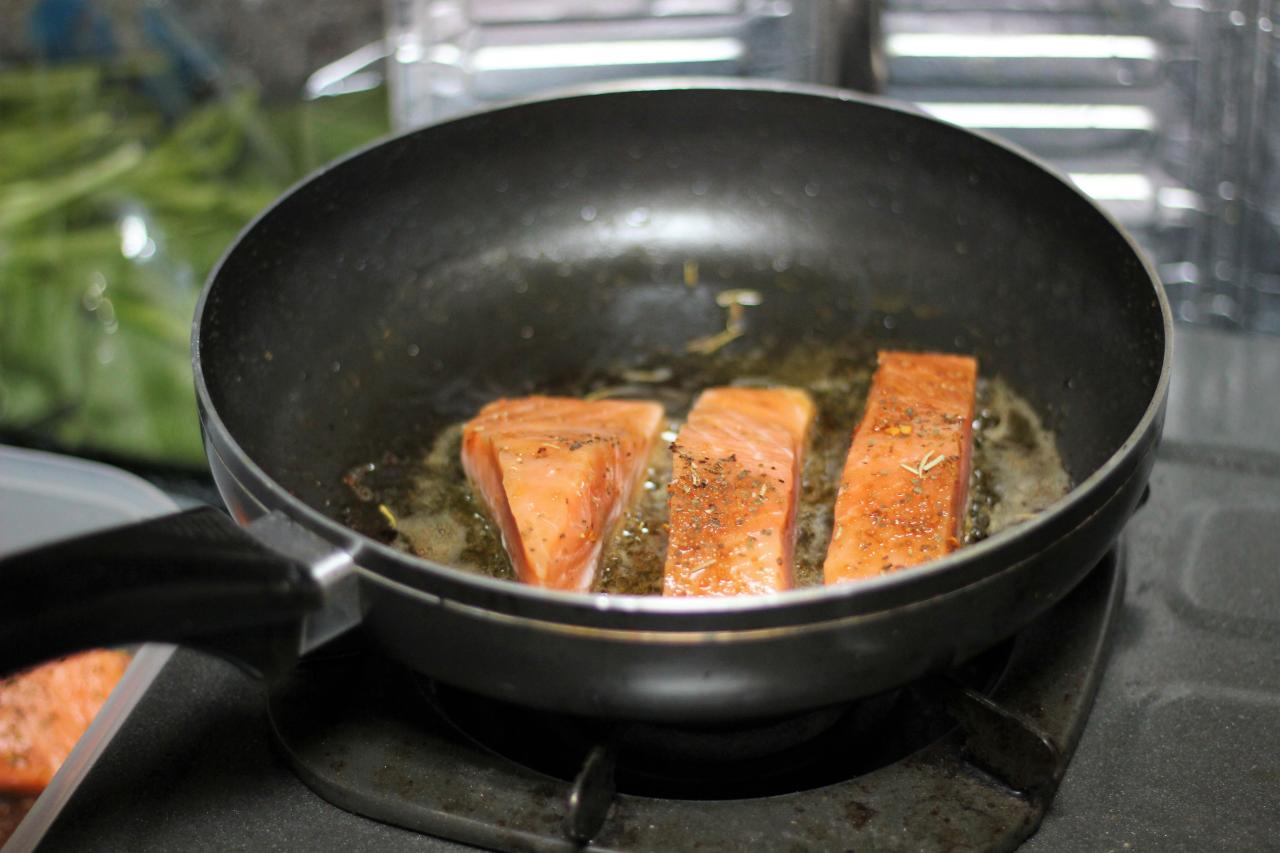
1. Selecting the Right Salmon
The first step in preparing salmon is choosing the right fillet. Here are some tips for selecting high-quality salmon:
- Freshness: Look for salmon with firm, moist flesh and a vibrant color. Fresh salmon should have a mild oceanic smell and should not have a strong fishy odor.
- Sustainability: Consider purchasing sustainably sourced salmon. Wild-caught Alaskan salmon and certain farmed varieties (like those certified by the Aquaculture Stewardship Council) are good choices for sustainability.
- Cut: Depending on your recipe, you might choose a whole fillet, portions, or steaks. Whole fillets are great for baking or grilling, while portions and steaks are ideal for pan-frying.
2. Prepping the Fish
Properly prepping the salmon before cooking can significantly improve the final dish. Here are the key steps:
Patting Dry
One of the most important preparation steps is to pat the salmon dry with paper towels. Here’s why this is essential:
- Crisp Skin: Moisture on the surface of the skin can prevent it from crisping up during cooking. A dry surface ensures that the skin crisps up nicely when it hits the hot pan or grill.
- Prevents Sticking: A dry fillet is less likely to stick to the cooking surface, making it easier to handle and flip.
Seasoning
Seasoning the salmon before cooking enhances its natural flavors. Here are some tips for seasoning:
- Basic Seasoning: At a minimum, season the salmon with salt and pepper. Salt helps to draw out moisture and intensify the natural flavor of the fish.
- Herbs and Spices: Experiment with herbs and spices to add more depth to the flavor. Common additions include dill, parsley, garlic powder, paprika, and lemon zest.
- Marinades: For an extra flavor boost, you can marinate the salmon for 30 minutes to an hour. A simple marinade might include olive oil, lemon juice, garlic, and herbs.
3. Refrigeration for Crispier Skin
To achieve the crispiest skin, consider this additional step:
- Refrigerate Uncovered: Place the seasoned salmon in the refrigerator uncovered for about an hour before cooking. The dry, cold air will help wick away excess moisture from the skin, resulting in a crispier finish when cooked.
- Optimal Temperature: Ensure your refrigerator is at the optimal temperature (below 40°F or 4°C) to keep the salmon fresh while it dries out slightly.
4. Using the Right Tools
Having the right tools on hand can make the preparation process easier and more effective:
- Sharp Knife: Use a sharp knife to trim any excess skin or fatty edges from the fillet. A sharp knife also ensures clean cuts if you need to portion the salmon.
- Fish Tweezers: Salmon fillets often contain pin bones, which are small, thin bones that can be unpleasant to eat. Use fish tweezers or needle-nose pliers to remove these bones before cooking.
5. Brining for Extra Moisture
Brining is an optional step that can enhance the flavor and moisture content of the salmon:
- Simple Brine: Create a simple brine solution with 1/4 cup of salt dissolved in 4 cups of water. Submerge the salmon in the brine for about 15 minutes before rinsing and patting it dry.
- Benefits: Brining helps to season the fish throughout and can also help retain moisture during cooking, resulting in a juicier fillet.
6. Consider the Cooking Method
Different cooking methods may require slight variations in preparation:
- Pan-Frying or Grilling: For these methods, it’s crucial to ensure the skin is dry and the flesh is seasoned well. The high heat will crisp the skin and cook the flesh quickly.
- Baking: When baking, especially at high temperatures, laying the salmon on a bed of herbs or vegetables can add flavor and prevent sticking.
- Poaching or Steaming: For these moist cooking methods, it’s often best to remove the skin beforehand as it won’t crisp up and may become rubbery.
7. Avoiding Common Mistakes
To ensure your salmon preparation is flawless, avoid these common mistakes:
- Overcrowding the Pan: When pan-frying, avoid overcrowding the pan. This can cause the salmon to steam rather than sear, preventing the skin from becoming crispy.
- Too Much Oil: Use just enough oil to coat the pan lightly. Too much oil can cause splattering and greasy salmon.
- Cooking Cold Salmon: Let the salmon sit at room temperature for about 15 minutes before cooking. This ensures even cooking and prevents the fish from being undercooked in the center.
Cooking Methods

1. Pan-Frying
Pan-frying is a quick and effective way to cook salmon, particularly if you’re aiming for crispy skin. Here’s how to do it:
Steps for Pan-Frying:
- Preparation: Pat the salmon dry with paper towels to remove excess moisture. Season both sides with salt and pepper. If desired, add other spices or herbs.
- Heating the Pan: Use a heavy-bottomed skillet or non-stick pan. Heat a small amount of oil (such as vegetable or olive oil) over medium-high heat until shimmering.
- Cooking Skin Side Down: Place the salmon fillet in the pan, skin side down. Press down gently with a spatula to ensure the skin makes full contact with the pan.
- Cooking Time: Allow the salmon to cook undisturbed for most of the cooking time. Depending on the thickness of the fillet, this can take 4-6 minutes. You’ll know it’s ready to flip when the flesh is opaque up to about three-quarters of the way up.
- Flipping: Carefully flip the fillet and cook for an additional 1-2 minutes, or until the salmon reaches your desired doneness.
Advantages of Pan-Frying:
- Crispy Skin: Pan-frying is the best method for achieving crispy skin.
- Quick Cooking: This method cooks salmon quickly, making it ideal for weeknight dinners.
- Flavor: The high heat caramelizes the exterior, adding rich, savory flavors.
2. Baking
Baking is a versatile method that is great for cooking multiple fillets at once. It’s also a gentle cooking method that can help prevent the fish from drying out.
Steps for Baking:
- Preheating the Oven: Preheat your oven to 400°F (200°C).
- Preparation: Pat the salmon dry, then season with salt, pepper, and any other desired herbs or spices. You can also marinate the salmon for extra flavor.
- Using a Baking Sheet: Place the salmon fillets on a lined baking sheet (parchment paper or foil works well). For extra flavor, place the fillets on a bed of sliced lemons or herbs.
- Cooking Time: Bake the salmon for 12-15 minutes, depending on the thickness of the fillets. Salmon is done when it flakes easily with a fork and has reached an internal temperature of 145°F (63°C).
Advantages of Baking:
- Even Cooking: Baking provides even, consistent heat, which helps to cook the salmon uniformly.
- Hands-Off Method: Once the salmon is in the oven, there’s minimal active cooking required.
- Moisture Retention: Baking helps retain the salmon’s natural moisture, preventing it from drying out.
3. Grilling
Grilling salmon imparts a smoky flavor that can’t be achieved with other methods. It’s perfect for summer meals and outdoor gatherings.
Steps for Grilling:
- Preparation: Pat the salmon dry and season. For grilling, a simple olive oil, salt, and pepper seasoning works well, but you can also use marinades.
- Preheating the Grill: Preheat the grill to medium-high heat. Clean and oil the grill grates to prevent sticking.
- Cooking Skin Side Down: Place the salmon fillets skin side down on the grill. Close the lid to maintain even heat.
- Cooking Time: Grill for about 6-8 minutes, depending on the thickness of the fillet. Flip the salmon only once, halfway through cooking. Use a spatula to gently turn the fillet.
- Checking Doneness: The salmon is done when it flakes easily with a fork and has reached an internal temperature of 145°F (63°C).
Advantages of Grilling:
- Smoky Flavor: The grill imparts a delicious smoky flavor to the salmon.
- Charred Skin: Grilling can give the skin a unique charred texture that is highly appealing.
- Outdoor Cooking: Grilling is perfect for outdoor cooking, especially in warm weather.
4. Poaching
Poaching is a gentle cooking method that is ideal for creating tender, delicately flavored salmon. This method involves cooking the fish in a flavorful liquid.
Steps for Poaching:
- Preparing the Poaching Liquid: In a large pan or skillet, combine water, white wine, lemon slices, bay leaves, and aromatics like dill, parsley, or thyme. Bring the liquid to a simmer over medium heat.
- Adding the Salmon: Place the salmon fillets in the simmering liquid. Ensure the liquid covers the fish completely.
- Cooking Time: Poach the salmon for 10-15 minutes, depending on the thickness of the fillets. Do not let the liquid boil, as this can make the salmon tough.
- Checking Doneness: The salmon is done when it turns opaque and flakes easily with a fork.
Advantages of Poaching:
- Moist and Tender: Poaching keeps the salmon moist and tender.
- Delicate Flavor: The gentle cooking method preserves the delicate flavor of the salmon.
- Healthy Cooking: Poaching is a healthy cooking method as it doesn’t require any added fat.
5. Broiling
Broiling is similar to grilling but done in the oven. It’s a quick method that uses high heat to cook the salmon rapidly.
Steps for Broiling:
- Preheating the Broiler: Set your oven’s broiler to high and let it preheat.
- Preparation: Pat the salmon dry, then season with salt, pepper, and any other desired seasonings. You can also brush it with a bit of oil.
- Using a Broiler Pan: Place the salmon on a broiler pan or a baking sheet lined with aluminum foil.
- Cooking Time: Broil the salmon about 6 inches from the heat source. Cook for 5-7 minutes, depending on the thickness of the fillet. There’s no need to flip the salmon.
- Checking Doneness: The salmon is done when it flakes easily with a fork and has reached an internal temperature of 145°F (63°C).
Advantages of Broiling:
- Quick Cooking: Broiling cooks the salmon very quickly, making it ideal for busy weeknights.
- High Heat: The high heat of the broiler gives the salmon a nicely browned, slightly crispy exterior.
- Simple Preparation: Broiling requires minimal preparation and cleanup.
6. Sous Vide
Sous vide is a precise cooking method that involves vacuum-sealing the salmon and cooking it in a water bath at a controlled temperature.
Steps for Sous Vide:
- Preparation: Season the salmon fillets with salt, pepper, and any desired herbs or spices. Place the fillets in vacuum-seal bags, adding a little olive oil or butter if desired.
- Setting the Temperature: Set your sous vide machine to 125°F (52°C) for medium-rare, or 130°F (54°C) for medium.
- Cooking Time: Place the vacuum-sealed bags in the water bath and cook for about 45 minutes to 1 hour.
- Finishing the Salmon: Once the salmon is cooked, you can sear it in a hot pan for a minute on each side to add a crispy exterior, if desired.
Advantages of Sous Vide:
- Perfect Doneness: Sous vide ensures the salmon is cooked evenly and to your desired level of doneness every time.
- Moist and Tender: The gentle cooking process preserves the salmon’s moisture and texture.
- Flavor Infusion: Vacuum-sealing the salmon with seasonings allows the flavors to infuse deeply into the fish.
Tips for Perfect Salmon
1. Choosing Fresh Salmon
The quality of your dish starts with the fish itself. Here’s how to pick the best salmon:
- Color: Look for vibrant, uniform color. Fresh salmon should be a rich, pinkish-orange hue. Avoid fish with any brown or dull spots.
- Smell: Fresh salmon should smell clean and slightly briny, like the ocean. It should not have a strong fishy odor.
- Texture: The flesh should be firm and spring back when touched. If it feels mushy or leaves an indentation, it’s not fresh.
- Skin: If buying salmon with the skin on, ensure the skin is shiny and moist, not dry or slimy.
2. Preparing the Salmon
Proper preparation can make a significant difference in the final dish:
- Pat Dry: Always pat the salmon fillets dry with paper towels before cooking. Removing excess moisture ensures a better sear and prevents sticking.
- Season Generously: Season both sides of the salmon with salt and pepper. You can also add other spices and herbs to enhance the flavor.
- Let it Sit: Allow the salmon to sit at room temperature for about 15-20 minutes before cooking. This helps it cook more evenly.
3. Using the Right Pan
The type of pan you use can affect the cooking process:
- Non-Stick Skillet: Ideal for preventing sticking, especially if you’re pan-frying.
- Cast Iron Skillet: Retains and distributes heat evenly, great for achieving a good sear.
- Oven-Safe Pan: Perfect for starting the salmon on the stovetop and finishing it in the oven for even cooking.
4. Temperature Control
Cooking salmon at the right temperature is crucial for perfect results:
- Medium-High Heat for Searing: Start with medium-high heat to achieve a crispy skin when pan-frying or grilling.
- Moderate Oven Temperature: For baking, a moderate oven temperature (about 400°F or 200°C) ensures even cooking without drying out the fish.
- Gentle Heat for Poaching: Keep the poaching liquid at a gentle simmer, not a boil, to maintain the fish’s tenderness.
5. Avoid Overcooking
Overcooked salmon can become dry and tough. Here’s how to avoid it:
- Monitor Cooking Time: Keep a close eye on the salmon, as cooking times can vary based on the thickness of the fillets and the cooking method.
- Check for Doneness: Salmon is done when it flakes easily with a fork and has reached an internal temperature of 145°F (63°C). For a more tender texture, you can cook it to medium-rare (about 125°F or 52°C).
- Resting Time: Allow the salmon to rest for a few minutes after cooking. This lets the juices redistribute throughout the fillet.
6. Preventing Sticking
Sticking can ruin the presentation and texture of your salmon:
- Preheat the Pan: Ensure your pan is properly preheated before adding the salmon. A hot pan helps create a non-stick surface.
- Use Enough Oil: A light coating of oil on the pan can prevent the salmon from sticking. Brush the salmon with oil as well.
- Non-Stick Spray: For extra insurance, you can use a non-stick cooking spray on your pan.
7. Flavor Enhancements
Enhancing the flavor of salmon can take your dish to the next level:
- Marinades: Marinating the salmon before cooking can infuse it with additional flavors. Use ingredients like citrus, soy sauce, garlic, and herbs.
- Seasoning Blends: Experiment with seasoning blends like Cajun, lemon pepper, or dill for added flavor.
- Finishing Touches: Add a squeeze of fresh lemon juice, a sprinkle of fresh herbs, or a drizzle of a complementary sauce just before serving.
8. Cooking Skin-On vs. Skinless
Decide whether to cook your salmon with the skin on or off based on your desired outcome:
- Skin-On: Cooking salmon with the skin on helps protect the delicate flesh from direct heat, adds flavor, and creates a crispy texture.
- Skinless: Opt for skinless fillets if you prefer not to eat the skin or if your recipe calls for poaching or other methods that don’t benefit from crispy skin.
9. Utilizing Leftovers
Salmon leftovers can be just as delicious:
- Storage: Store cooked salmon in an airtight container in the refrigerator for up to three days.
- Reheating: Gently reheat leftovers in a low oven or microwave to avoid drying them out.
- Repurposing: Use leftover salmon in salads, sandwiches, or pasta dishes for a quick and flavorful meal.
Health Benefits of Salmon Skin
:max_bytes(150000):strip_icc()/__opt__aboutcom__coeus__resources__content_migration__serious_eats__seriouseats.com__images__2012__06__20120617-salmon-how-to-pan-roast-09-dd70fcf9e8754d28b9adbefa16f633bb.jpg)
1. Rich in Omega-3 Fatty Acids
Salmon skin is packed with omega-3 fatty acids, particularly EPA (eicosapentaenoic acid) and DHA (docosahexaenoic acid). These essential fats play a crucial role in supporting heart health, brain function, and reducing inflammation in the body. Incorporating omega-3s into your diet can lower the risk of cardiovascular disease, improve cognitive function, and promote joint health.
2. High Protein Content
Salmon skin is an excellent source of protein, providing a complete amino acid profile. Protein is essential for building and repairing tissues, supporting muscle growth, and maintaining a healthy metabolism. Including protein-rich foods like salmon skin in your diet can help you feel full and satisfied, making it easier to manage weight and prevent overeating.
3. Source of Essential Nutrients
In addition to omega-3s and protein, salmon skin contains several essential nutrients, including:
- Vitamins: Salmon skin is rich in vitamins B6 and B12, which play key roles in energy metabolism, nerve function, and red blood cell production.
- Minerals: It provides minerals like potassium, selenium, and phosphorus, which are vital for maintaining electrolyte balance, supporting immune function, and promoting bone health.
- Antioxidants: Salmon skin contains antioxidants like astaxanthin, which help protect cells from damage caused by free radicals and oxidative stress.
4. Healthy Fats
While some people may be concerned about the fat content in salmon skin, it’s important to note that the majority of the fat is healthy unsaturated fat. These fats can help improve cholesterol levels, reduce the risk of heart disease, and support overall cardiovascular health. Including moderate amounts of healthy fats in your diet, such as those found in salmon skin, can contribute to a well-balanced and nutritious eating plan.
5. Improves Skin Health
Ironically, consuming salmon skin can also benefit your own skin. The omega-3 fatty acids, along with the vitamins and minerals found in salmon skin, contribute to healthy skin by promoting hydration, reducing inflammation, and supporting collagen production. Including salmon skin in your diet may help improve skin elasticity, reduce the appearance of wrinkles, and promote a radiant complexion.
6. Boosts Brain Function
The omega-3 fatty acids in salmon skin are highly concentrated in the brain and play a crucial role in cognitive function and mental health. Regular consumption of omega-3s may help improve memory, concentration, and mood, while also reducing the risk of age-related cognitive decline and neurodegenerative diseases like Alzheimer’s.
7. Supports Eye Health
Omega-3 fatty acids are also beneficial for eye health, particularly DHA, which is a major structural component of the retina. Including salmon skin in your diet can help protect against age-related macular degeneration, dry eye syndrome, and other eye conditions by reducing inflammation and promoting optimal retinal function.
When to Avoid the Skin
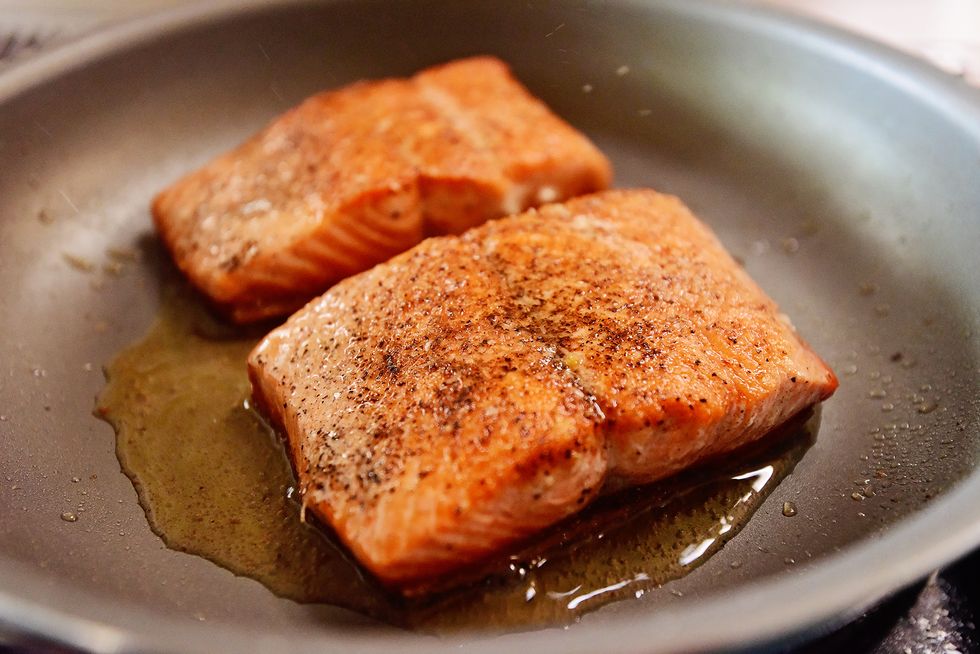
1. Environmental Contaminants
Salmon skin, like the flesh, can accumulate environmental contaminants such as mercury, PCBs (polychlorinated biphenyls), and dioxins. These pollutants can be present in the water where the salmon live and can bioaccumulate in their tissues over time. Individuals who are concerned about exposure to these contaminants may choose to avoid eating the skin, particularly if they consume salmon frequently or are at higher risk of adverse health effects.
2. Allergies and Sensitivities
Some people may have allergies or sensitivities to certain proteins found in fish skin, leading to allergic reactions or digestive issues. If you have a known allergy to fish or seafood, it’s essential to avoid consuming the skin to prevent an adverse reaction. Additionally, individuals with sensitive digestive systems may find that fish skin is difficult to digest, leading to discomfort or gastrointestinal symptoms.
3. Cooking Methods
Certain cooking methods can affect the texture and palatability of salmon skin, making it less appealing to eat. For example:
- Boiling or Stewing: Cooking salmon skin using wet methods like boiling or stewing can result in a soft, slimy texture that some people may find unappetizing.
- Slow-Roasting: Slow-roasting salmon with the skin on may not allow the skin to crisp up properly, resulting in a less enjoyable eating experience.
- Undercooking: If salmon skin is not cooked thoroughly, it may remain tough and chewy, detracting from the overall enjoyment of the dish.
4. Preparation Preferences
Some individuals simply prefer the taste and texture of salmon without the skin. While the skin can add flavor and texture to the dish, personal preferences vary, and some people may choose to remove it before cooking or serving. Additionally, recipes that call for skinless salmon, such as sushi or ceviche, may not benefit from including the skin.
Conclusion
Cooking salmon skin side down is the best way to achieve a flavorful, crispy exterior while protecting the delicate flesh from overcooking. Whether you pan-fry, bake, or grill your salmon, following these tips and techniques will help you create a delicious and perfectly cooked dish every time. Remember to select high-quality salmon, keep it dry, and handle it minimally for the best results. Enjoy experimenting with different flavors and savor the rich, nutritious benefits of salmon and its crispy skin.

